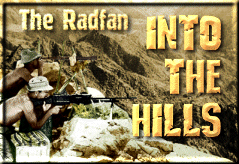The Assault on Cap-Badge

Under pressure from the public, the Protectorate sheiks invoked the Defence Treaty and called for help. The British sent in 45 Commando to lead the advance up the Dhala road. 45 Commando was commanded by Lt-Colonel T.M.P (Paddy) Stevens, a World War Two D-Day veteran. He had anticipated a return to Aden and had already drawn up a plan for the pursuit of the tribesmen.
Heavy training ensued, and shortly afterward, the advance commanded by brigadier Hardgroves began. Colonel Stevens task was to penetrate the Radfan and take a hill, code named 'Cap-Badge' in the middle of the area from which his force would dominate the principal village, Danaba, which was known to be a tribal stronghold. Within his command, Stevens had 45 Commando, 'B' Company 3 Para and 'A' Squadron, 22 SAS regiment plus helicopters, Royal Engineers, the guns of 'J' Battery, Royal Horse Artillery and some Federal units.
45 Commando were tasked to seize the 'Cap-Badge' feature, which divided the Wadi Taym from the Danba basin, two fertile and populous areas which the tribesmen would be sure to defend. Another feature lay to the north of the Danaba basin, a long ridge code-named 'Rice-Bowl'. The secret was to take the high ground and hold it. 45 Commando went in by night, skirting or taking two other features. As 45 marched in, The Paras would drop onto the Wadi Taym, onto a Drop Zone held by the SAS and hold until 45 Commando arrived. The advance from Thumier began on 30th April 1964.
The 10 am SAS patrol tasked with seizing the Drop Zone for the Paras had infiltrated towards 'Cap-Badge' but were discovered by a shepherd early on the morning of the 30th and soon surrounded by swarming tribesmen coming up from Danada. The SAS lost their commander, Captain Edwards, and their radio operator as they come under heavy fire. The RAF Hunters were called in to strafe the attackers and the SAS withdrew but were forced to leave their dead behind. The parachute drop was called off, but 45 Commando had began their march.
In spite of the rough terrain and heavy loads, 45 Commando made good progress the first night and a radio message warned them that the drop had been cancelled and that the 3 Para were coming up by road to join them. Stevens was ordered to 'hold firm' on 'Coca Cola' and 'Sand Fly' and await further orders.
The going was bad, and very difficult especially for the Heavy Weapons troop with their mortars and machine guns. But by first light, both features were under 45's control. But the Marines had now lost their element of surprise and could expect stiff opposition when they moved on 'Cap Badge'.
Stevens elected for a night approach on the 6th objective, which was a 1,000ft plus mountain. The Marines probed for five days and then were relieved on the two features by the Royal Anglian Regiment. The Marines and 3 Para descended into the valley, skirted the village and 'X' company led the way up the rock faces. The Marines and Paras were in position by first light. 3 Para captured the village of El Naquil losing six wounded and two dead before the enemy positions were overran. 'Z' Company of 45 reinforced them before the positions could be consolidated. The tribesmen came out to fight occupying stone 'sangars' on the slopes of the hills and the RAF Hunters were called into to blast them out with rockets. The Paras stayed on for a week before returning to Dhala to prepare for the next phase of the operation.



